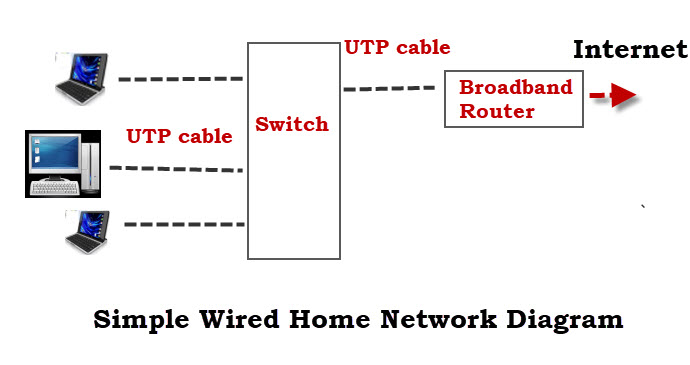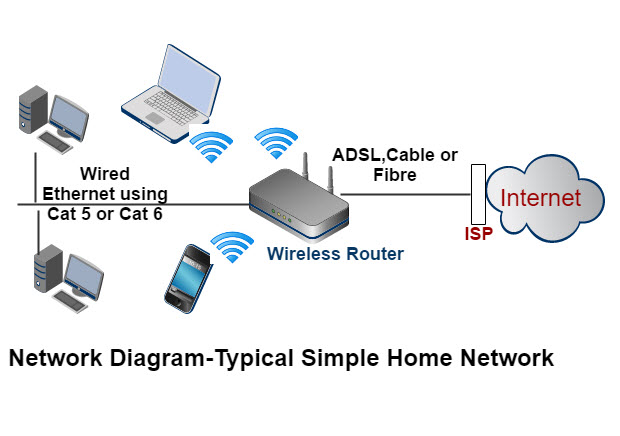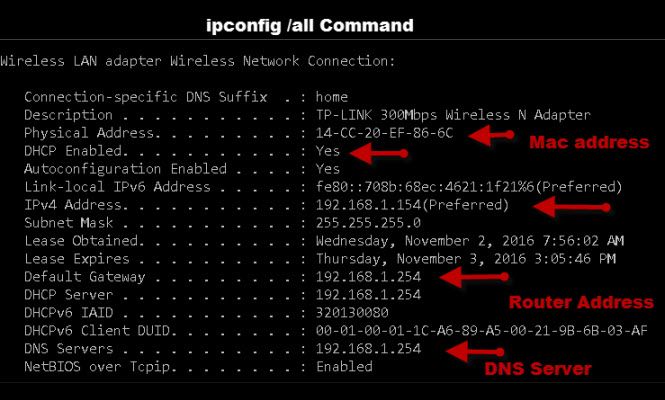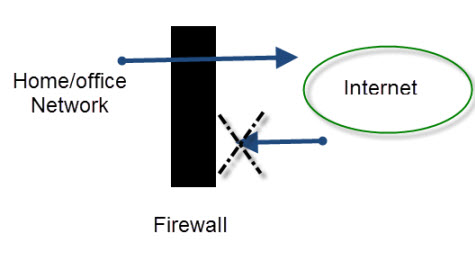How To Set Up A New Network Connection
 Today almost every dwelling house and small office has a local network, and an Cyberspace connectedness.
Today almost every dwelling house and small office has a local network, and an Cyberspace connectedness.
The home network or small area network enables multiple devices e.one thousand. PCs,tablets etc to connect to each other, and also to connect to the internet.
In this tutorial you will acquire how y'all to build and setup a dwelling house or small area network and connect information technology to the Internet.
Quick Links
- Choosing a Wired or Wireless Network
- Setting up a Home Network -Components and Structure
- Extending Your Home Network
- Home Network IP Addresses
- Firewall Configuration on Domicile Networks
- Checking Network and Internet Speeds
- Home Network and Cyberspace Connexion Problems
- Quiz
Choosing a Wired or Wireless Network
Practice You Build a wired or Wireless Network? which is all-time?
Early (pre 2008) dwelling house networks were predominately wired networks.
Wired networks use Ethernet over UTP cable and tend to be faster than wireless networks, which is an important consideration if you lot are a gamer. The simple wired dwelling house network diagram below shows a minimum setup with a switch and broadband router.

Wired Network Advantages
- Fast typically 100 Mbps to 10 Gbps
- Secure and reliable.
Wired Network Dis-Advantages
- Doesn't work with devices that don't have an Ethernet port eastward.g. tablets and smart phones.
- Non then easy and fast to setup as it requires running cables. Nevertheless Homeplug or powerline adapters tin can be used instead.
- Non so easy for visitors and mobile devices (laptops) to connect to.
Main Uses
It Is best used for network backbone i.e. connecting between router,network switches and wireless access points on unlike levels (floors).
See How to Wire your Home Network
Home Wireless Networks
Wireless networks utilise Wi-Fi. and are quick and easy to install, simply are generally slower than wired networks. See Wi-Fi and Wireless networks for more details.
Wireless Network Advantages
- Like shooting fish in a barrel to setup from an end user perspective.
- Allows easy access to smart phones, Tablets and mobile devices.
- No cables to run.
Wireless Network Dis-Advantages
- Not as Secure equally wired networks without proper configuration, and easy to setup insecurely.
- Non every bit fast every bit wired networks.
- Not every bit reliable every bit wired networks.
Main Uses
Connecting peripheral devices like computers,smart telephone,tablets etc.
Almost home networks volition utilize a mixture of wired and wireless.
Setting up a Dwelling house Network -Components and Construction
Today however well-nigh home and small home office networks will use a wireless network or mixed network, as most people use Smart phones, and tablets which don't have Ethernet support.
The main components required to build a typical home/small office network are:
- Router or Wireless router – Connects the network to the Internet.
- Wireless Access Signal – Used to Connect Wi-Fi equipped devices to the network.
- Ethernet HUB or Switch -Used to Connect Ethernet equipped devices.
- Cablevision cat five, cat5e or cat 6 with RJ45 connectors.
- Telephone Cable with RJ 10 connectors.
- Broadband Filters.
The domicile network diagram below shows the structure of a typical modest home network
For most domicile networks the Wireless Router or Hub which connects the network to the Internet volition be the main component of the home or small-scale dwelling office network, and in many cases information technology will be the only component.
The Wireless router usually incorporates a Wireless access bespeak,Ethernet switch, DSL modem and Router in a single box.
This short video shows how to use a Wireless Abode Hub ( BT) or router to create a home network that is continued to the Internet.
Video Notes:
DSL Modem– converts digital signals into counterpart signals that are suitable for sending over a phone line. It is normally built into the Internet/broadband router and is not normally purchased as a separate component.
DSL/Broadband Filter– Used to filter out DSL signals from telephone signals so that you can access the net and use the telephone simultaneously. Oftentimes included as part of the connection socket.
See How to Setup and Configure your Domicile Router
Wireless Router Location
The Wireless router will demand to connect to the phone line, cable or fibre network admission signal in your home.
Therefore most people locate the Wireless router about to the main telephone socket.
Withal you can usually alter the location past using telephone extension cables or longer WAN cables.
Notation: WAN cables use the same connectors (RJ45), and cables as Ethernet cables.
Because the Wireless Router provides the Wireless access point then yous should identify it in a key location, if possible, to get the all-time wireless reception.
Don't
- Hide it in a cupboard
- Install it behind the sofa
- install next to motors,microwaves,cordless telephones
Testing Your Wireless Bespeak
The easiest way of testing y'all betoken strength in diverse locations is to apply the inSSIDer Wi-Fi checker which is an App that you can install on your Android Tablet or telephone.
The general idea is to place the Wireless router in its preferred location and then motility around the business firm with the inSSIDer Wi-Fi checker, and cheque the signal strength, and then suit the location if necessary.
Extending Your Dwelling Network
In big homes/offices it may not be possible to connect all devices straight to the Wireless router and and so you volition need to purchase boosted networking components.
You can extend your abode network by:
- extending your Wi-Fi coverage by installing additional Wireless Access Points or a more than powerful access point.
- or yous can extend the Wired network by running cables into other rooms
- or using your power cables by installing home plug adapters. See How to extend a Abode Network
Home Router Setup
To administer the home router you access it via a web browser, and login using a username and password.
Earlier you lot allow devices to connect to your home network you should make some basic changes to the default setup parameters of your router.
The two important ane are the SSID used to access the Router and the router admin password every bit the default username/passwords are well known, and published on the Internet.
See How to Setup and Configure your Home Router and Setting upwards a secure wi-fi habitation network.
Connecting Wi-Fi Devices
The standard way of connecting a Wi-fi device to a Wi-fi network is the connect to the network and enter the password when prompted.
However most modern Wi-Fi routers/hubs support a feature chosen WPS ( Wi-fi protected setup). Which ordinarily involves pressing a button on the wi_fi router and a respective WPS connectedness button on the Device.
The devices then connect without requiring you to enter a password. Run into Wiki on WPS
Domicile Network IP Addresses
All of your devices will need an IP address.
This is provided automatically by a service called DHCP which, by default, is provided past the home router.
IP address provided by the DHCP server are known as dynamic addresses, every bit they can change. Y'all can likewise assign addresses manually, and these are known as static addresses.
Static Addresses are not commonly assigned but are oftentimes required when using Port forwarding.
They can exist assigned on the network settings of the device, but preferably on the DHCP server using reserved addresses.
Additionally the addresses used on your home network are known as internal addresses.
When yous connect to the Internet your device volition use an external IP address. This accost is the IP accost of the router/hub. See Internal vs external IP addresses for a more detailed explanation.
Finding Your DNS, IP, MAC Addresses and Router IP Addess
You may need to observe out what DNS servers you are using or the IP or MAC address of:
- Your Domicile Router.
- Your own reckoner/tablet/telephone
The chief tool yous use is the ipconfig (windows) or ifconfig (linux) tool.
The screen shot below shows the ipconfig command apply with the /all switch. i.east. ipconfig/all

Your home router is your gateway to the Internet. When viewing your configuration some devices refer to it as the default router whereas other use the term default gateway.
In the screen shot higher up it is 192.168.ane.254
Splitting Your Dwelling Network
For security reasons you may find the need to divide your home network. This is particularly true in minor business networks similar restaurants etc were customers are besides given access to the network.
Many modern routers will provide invitee networks for this purpose, and is easy to setup.
Another mutual method, only not every bit uncomplicated is to apply VLANs. See Understanding and using VLANs
Firewall Configuration on Home Networks
A Firewall functions like a router, and more often than not what y'all employ on small networks is firewall/NAT router combination in which a single device acts as a NAT router and firewall.
A firewall protects your home or small business concern network computers and devices from intruders on the Internet.
Information technology finer acts similar a one style digital gate blocking admission to your network from devices on the Internet, but at the same time allowing devices on your network to connect to devices on the Internet. (schematic diagram beneath)

For small home/function networks the firewall is built into, and is part of, the router that connects to the Internet.
Generally in that location is no configuration required as the default behaviour is just to let connections from the local network to the Internet, and not from the Internet to the abode network.
However if you practise require devices on the Internet to connect into your network (often required by gamers) then you can configure port forwarding.
You may also desire or need to use dynamic DNS- see What is Dynamic DNS ? and Why Use Dynamic DNS Services?
Checking Network and Internet Speeds
On whatever network the speed is restricted past the slowest component.
A computer with a Gigabit network carte talking to a computer with a 100Mbit/s network menu is restricted to 100Mbit/s.
Shared devices like switches and Wireless admission points are network choke points just like traffic lights and roundabouts on a road.
LAN Speed exam is a very useful tool for testing your local network speeds. See understanding Habitation network speeds.
For Internet speeds yous tin apply online speed test sites. See Understanding Internet speeds and speed tests.
Home Network and Internet Connection Problems
You volition invariably have connection issues from fourth dimension to time.
In my experience well-nigh bug are easily diagnosed, and fixed with a little patience and perseverance.
Having a expert understanding of how your network fits together, and works is essential for successful troubleshooting.
Questions and Answers
Q- What is the difference between a router and a Wireless Access Point (WAP).
A- A router connects the dwelling house network to the Net a WAP connects a device to a network.
Q-How exercise I check mt home network Speed?
A- Meet Understanding home network speeds
Quiz
Home Networking Setup Quiz
0 of 10 questions completed
Questions:
- i
- two
- 3
- 4
- 5
- 6
- 7
- 8
- nine
- 10
Information
Quick Quiz to exam your cognition of smart Dwelling networking
Yous accept already completed the quiz before. Hence yous can not start it once again.
Quiz is loading...
You must sign in or sign upwardly to offset the quiz.
You accept to finish post-obit quiz, to first this quiz:
0 of x questions answered correctly
Your time:
Time has elapsed
You have reached 0 of 0 points, (0)
| Average score | |
| Your score |
Categories
- Not categorized 0%
- i
- two
- iii
- 4
- five
- 6
- 7
- 8
- 9
- x
- Answered
- Review
-
Question 1 of x
Wi-fi Networks are easier to setup than Wired Networks?
-
Question ii of 10
Wi-fi Networks are much faster than Wired Networks?
-
Question 3 of 10
You are getting a Bad Wi-Fi signal is some parts of your abode What can you try to solve the problem?
-
Question iv of 10
How do devices on a home network normally get an IP Address?
-
Question 5 of 10
On Nigh Home Networks the DHCP service is provided by which device?
-
Question vi of ten
A Wireless Home router ordinarily has Ethernet ports and a Wireless Access point built it?
-
Question 7 of ten
What device do you utilise between a ADSL router and the Telephone connectedness?
-
Question eight of 10
What should yous change on your Home Router before you Allow clients to Connect
-
Question ix of ten
Where Should you Identify your Wireless home Router?
-
Question x of 10
You must install and setup a DNS server to Access the Internet?
Related Tutorials and Resources:
- Understanding DHCP on Home Networks
- Using The Ping Control – Home Networking Testing
- Basic Home Network Hardware Components, Devices and Services
- 10 Useful Windows Networking Commands
- Setting Upwards A Static IP Address on Windows ten
Please Let me Know if you found information technology Useful
[Total: 105 Average: 3.5]
How To Set Up A New Network Connection,
Source: https://stevessmarthomeguide.com/build-home-network/
Posted by: trussarryin.blogspot.com


0 Response to "How To Set Up A New Network Connection"
Post a Comment